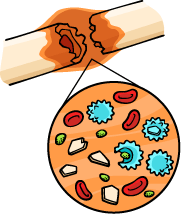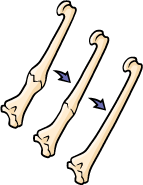Adults have 206 bones in their body that help protect the body's vital organs. Many people take bones as solid, lifeless matter, but in reality, your skeleton is as alive as your softer tissues and organs are. And you can often experience injuries that lead to fractures or broken bones. It heals through a series of stages that really make bones a living part of your being. Continue reading to learn more about the healing process of fractures.
How Do Broken Bones Heal?
The moment you sustain an injury that leads to a fracture or broken bone, your body activates itself to fix the injury. The length of recovery time depends on many factors, including your age and the location of the break. Below are the stages of bone healing.
Step One
A blood clot will form at the site within a couple of hours. The blood clot contains special cells called phagocytes that clean bone fragments and kill any germs around the break. These special cells are actually part of your immune system and help destroy unwanted bacteria and material.
Step Two
 A soft callus will later develop around the fracture. It is made mostly of collagen by another group of cells called chondroblasts. The formation of a callus may take anywhere between 4 days and 3 weeks.
A soft callus will later develop around the fracture. It is made mostly of collagen by another group of cells called chondroblasts. The formation of a callus may take anywhere between 4 days and 3 weeks.
Step Three
 After some time, osteoblast cells create new bone and turn a soft callus into a hard callus. It contains minerals to add hardness to the bone. You usually enter this stage a couple of weeks after the break. It usually completes anywhere from 6th week to 12th week.
After some time, osteoblast cells create new bone and turn a soft callus into a hard callus. It contains minerals to add hardness to the bone. You usually enter this stage a couple of weeks after the break. It usually completes anywhere from 6th week to 12th week.
Step Four
The last step involves remodeling of the bone. Osteoclasts are the special cells responsible for remodeling. These cells eliminate extra bone around the fracture and bring it back to its original shape. It is a very slow process and may take anywhere between 3 and 9 years to complete.
How to Help Heal the Broken Bones
Now you have a better understanding of "how do broken bones heal", but you also need to keep in mind that you can help heal your bones rather quickly by taking certain steps. For instance:
1. Cast Immobilization
It is important to put your broken bone back together before applying a cast. Your doctor may use a technique called "reduction", which involves pulling and fitting the ends of the bones together. Then, they will apply the cast because cast immobilization accelerates healing. You may first have to wear a splint usually made of fiberglass, and once the swelling reduces, they will put on a full cast after a week or so. Made of a hard covering and a soft padding, casts usually stay on for anywhere between 4 and 12 weeks.
2. Heat and Ice
It is important to take plenty of rest after you get a fracture. You should also keep your broken bone elevated and ice it regularly. Even if you are already wearing a splint, you should still consider icing the area to reduce inflammation and swelling. While it is important to take rest, do not go for complete bed rest. Controlled movement helps improve blood flow to the affected area and accelerate healing. When applying ice, repeat every 2-3 hours for 15-20 minutes per session.
3. Weight Bearing
Avoid putting weight on your broken bone to prevent further complications. If you have a fracture in your legs or pelvis, you should start putting weight gradually after a week of your injury. Immobilization because may result in loss of bone mineral and slow down the healing process. Use crutches to move around if you find it difficult to put any weight on the bone.
4. Supplements
Your doctor may recommend taking a supplement to provide you with key bone-healing vitamins and minerals. How do broken bones heal with the supplement? Taking supplements helps you get important nutrients without having to worry about increasing your caloric intake. Take a supplement that contains phosphorus, calcium, and magnesium because these are the main minerals found in bones. Your supplement should also contain trace minerals such as iron, zinc, copper, boron, and silicon, as well as vitamins such as vitamin K and vitamin D. You will have to take more than 1,200mg of calcium a day to accelerate the healing process.
5. Medications
You can take OTC pain relievers such as naproxen, ibuprofen, or aspirin to reduce pain and swelling. Taking these medications is only a short-term solution to alleviate pain and prolonged use can cause issues related to the kidneys, stomach, and liver. It is important that children under the age of 18 do not take aspirin because it increases the risk of Reye's syndrome. You can also take acetaminophen but never combine them with NSAIDs. Talk to your doctor to prescribe some powerful pain relievers if OTC medications do not prove effective.
6. Rehabilitation
It is natural for muscles around your affected area to look weak after the removal of your cast. Therefore, you have to consider some form of rehabilitation and work with a physical therapist to strengthen your muscles. They will teach you some strengthening and stretching exercises to help you recover quickly. You may have to go for physiotherapy twice a week for 4-8 weeks to get good results. Working with a physical therapist is important because they can also use techniques such as electrotherapy to strengthen your weak muscles.
So, keep in mind that knowing "how do broken bones heal" is important, but knowing what you can do to accelerate healing is even more vital. Work with your healthcare provider and follow their advice to avoid complications.
